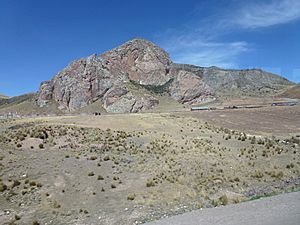Pucará, Puno facts for kids

Iglesia de Santa Isabel de Pucará, Perú
|
|
| Location | Peru, Puno Region |
|---|---|
| Region | Andes |
| Coordinates | 15°02′43″S 70°22′22″W / 15.04528°S 70.37278°W |
Pucará (pronounced Poo-kah-RAH) is a town in Peru. Its name comes from the Aymara and Quechua words for "fortress." This town is located in the Puno Region, not far from Lake Titicaca.
Near the town is an amazing ancient place called the Pucará archaeological site. It's very old, dating back to about 1,800 BC. This huge site covers an area of about 4.2 square kilometers. It was the first large city in this part of Peru. The site is so important that it gave its name to a special group of people called the Pukara culture. The government of Peru has declared it a National Cultural Heritage site.
Contents
Exploring the Ancient Pukara Center
The Pukara site was a very important place for both government and religion. It was like a capital city for the people who lived there long ago. The site had two main parts: a ceremonial area and a city area where people lived.
The ceremonial area has nine pyramids. They come in different shapes and sizes. The most important pyramid is called Kalasaya. This structure was built using huge, carefully shaped stones. It even has some cool stone sculptures. In front of the pyramid, there's a staircase leading to an upper temple. This staircase is decorated with tall, carved stones called stelae. These carvings show pictures of mythical creatures, people, and animals like frogs, snakes, fish, and pumas.
There was also a large, sunken courtyard in the center of the site. This courtyard also had many carved stone stelae.
Understanding the Pukara Culture
The Pukara culture was very important in the area north of Lake Titicaca. Their main center was the Pukara site itself. This culture grew and included earlier communities, like those from the Chiripa period. By about 200 BC, the Pukara culture was the most powerful group around the entire lake region.
The Pukara people were skilled farmers, herders, and fishers. They lived in small towns and villages. These smaller communities were all ruled from the main Pukara city.
The Pukara people were also great artists, especially with pottery. Their pottery is known for its beautiful colors and fine craftsmanship. They made many special items that weren't just for everyday use. These included pottery shaped like humans and animals.
Pukara pottery and woven fabrics have been found in many places. They reached far into the middle Andes mountains and even to the Pacific coast of Peru and Chile.
Around 200 AD, another powerful culture called Tiwanaku began to rise. This might have caused the Pukara culture to become weaker.
The Older Qaluyu Culture
About 4 kilometers from Pukara is another ancient site called Qaluyu. This site is important because it represents the Qaluyu culture. This culture existed before the Pukara culture. Qaluyu is a medium-sized mound, covering about 7 hectares. It was first found by Manuel Chávez Ballón. Later, in 1955, Alfred Kidder and Ballón did some digging there.
The Qaluyu culture was the main early culture in the northern part of the Titicaca Basin. It is believed to have existed from about 1400 BC to 500 BC. In fact, archaeologists have found signs of Qaluyu settlements right underneath the main temples at Pucara.
Recently, more Qaluyu period settlements have been found. These are near the towns of Arapa and Taraco. They have also been found in the Huancane-Putina river valley. Some of these new sites are quite large, even bigger than Qaluyu itself. They are located about 40 to 60 kilometers west of Pukara.
Near the town of Taraco, recent studies have shown a long history of both Qaluyu and Pucara cultures. Many carved stones (stelae) from both cultures have been found there too.
Images for kids
See also
 In Spanish: Pucará (Lampa) para niños
In Spanish: Pucará (Lampa) para niños



